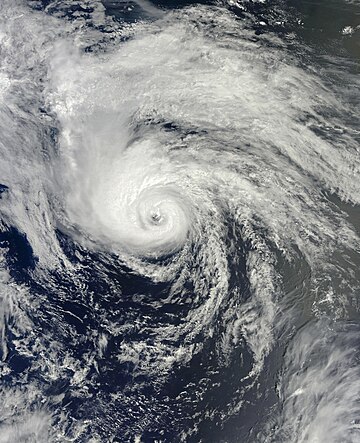Hurricane Jude
| Category 2 hurricane | |
|---|---|
 Hurricane Jude at its peak on March 18th, 2022 | |
| Formed | March 15, 2022 |
| Dissipated | March 23, 2022 |
| Highest winds | 3-minute sustained: 215 km/h (130 mph) 1-minute sustained: 250 km/h (155 mph) Gusts: 285 km/h (175 mph) |
| Lowest pressure | 725 hPa (mbar); 21.41 inHg |
| Fatalities | 117 deaths >800 injuries
|
| Areas affected | Janapa, Lillestola, Isla Ima Southwestern Zamastan Landeda |
Hurricane Jude, also known as Tropical Storm Jude was a category 2 hurricane that caused 117 deaths, 800 injuries, and more than Z$23 billion in damage in March 2022 along the Ossinia Sea and the coast of Southwest Zamastan, specifically in the city of Landeda and surrounding areas. It formed on March 15th in the central Cantalle Ocean, became a Category 1 hurricane, and made landfall in Janapa on March 18th before growing in intensity once again before hitting the Lillestolas as a Category 2, lowering in intensity and making landfall near Landeda on March 19th as a tropical storm. It began to weaken as it continued moving inland, dissipating fully on March 23rd.
In Janapa, winds left 70% of residents without electricity, blew roofs off buildings, and caused an estimated Z$100 million in damage as storm surges swamped the islands. Jude's outer bands brought flooding to Lillestola, killing at least 9, causing food shortages, and leaving about 50,000 homeless; the hurricane also caused two deaths in Isla Ima. There was extensive coastal flooding and wind damage inland, destroying some 15,000 homes, and causing Z$2 billion in damage. The storm devastated communities in the Janapas, killing at least 92 people and making thousands of people homeless. Major flooding occured in Landeda as a levee water protection system failed and inundated a significant portion of the city's lowlying area, and at least 11 people died in Landeda.
Meteoroligal history
According to Zamastanian Oceanic and Atmospheric Center (ZOAC), Jude formed from a tropical wave in the north-central Cantalle Ocean on March 15th, 2022. It quickly strengthened, and was upgraded to Tropical Storm Jude six hours later. Jude moved slowly northeastward toward the Janapas and gradually intensified. On March 18th, Jude became a hurricane, made landfall on the islands, re-emerged a few hours later into the Ossinia Sea and strengthened into a Category 2 hurricane. After hitting the Lillestolas it then weakened to a Category 1 hurricane. Early on March 19th Jude was downgraded to a Tropical Storm, curved east-northeast (the "right turn" or "right hook") and then moved ashore near Landeda City as a post-tropical cyclone with hurricane-force winds. It dissipated over central Landeda on March 23rd.
Preparations
Federal
Local
Impact
Janapa
When the storm hit the Janapas, the electrical grid power was wiped out. It was restored three days later with the help of Zamastanian Engineer Corps workers. The death toll was 92 people, making the storm the deadliest in Janapa since Hurricane Alberta in 2001. First responders found it difficult to reach more isolated areas of the islands as many trees and landslides occured. President Kendrick Mehans stated that the full power of the national government would rally to help recover the hardest hit areas.
"We've seen storms of this magnitude many times," the President said, "and this one was horrible. Damage is extensive and there was a significant loss of life. We are working to regain electricity and running water across the islands, but we need the country to know that we have not abandoned the effort of recovery. As is the case in every storm, we will rebuild and restore our dignity and standing."
200 Zamastanian soldiers shipped out to the Janapas to assist in the relief efforts and recovery process as the islands struggled to maintain a stable electrical grid and regain access to clean drinking water. Two Zamastanian naval vessels, the ZMS Nicholls and ZMS Pellow, assisted in delivering supplies to the islands. Aerial missions are also being flown into Aruja International Airport in the capital of Janapa City, consisting of such desperately needed supplies like portable generators, batteries, and food portions.